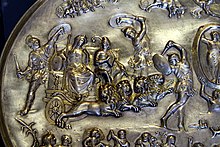Parabiago Plate
 From Wikipedia the free encyclopedia
From Wikipedia the free encyclopedia


The Parabiago plate, also known as the Parabiago patera,[a] is an ancient Roman circular silver plate depicting mythological figures. It was found in an ancient Roman cemetery at Parabiago, near Milan, in 1907.[1] The plate depicts Cybele with her consort Attis in a "vast cosmic setting"[2] amid "sun, moon, earth and sea, time and the seasons."[3] At the time of its discovery, it was thought to have been used as a lid for a funerary amphora.[4]
The plate is difficult to date. Earlier scholars tended to date it to the 2nd century CE, because of its classicizing style, but stylistic characteristics also permit a later date. Technical analyses, however, support a provenance in the 4th–5th centuries, even though it bears little stylistic resemblance to other silver pieces from that period.[1]
Description[edit]
The plate weighs 3555 g and measures 390 mm in diameter. It has a foot-ring of 26 mm in height. The surface is worked with figures in high relief.[1]
- Center left: Cybele and Attis ride in a quadriga pulled by four lions. They are accompanied by three Corybantes.
- Center right: Rising from the ground is a nude youth who holds up a zodiac ring surrounding Aion, wearing a chiton and holding a sceptre.[5]
- Far right center: A snake twines around an obelisk or gnomon.[6]
- Upper left: The Sun rising in his chariot, preceded by the winged, torch-bearing morning star, Phosphorus.
- Upper right: The Moon setting in her chariot (biga), preceded by the evening star, Hesperus, also winged and carrying a torch.
- Lower center: Four erotes representing the seasons hover above Oceanus and Tethys.
- Lower left: Two river nymphs.
- Lower right: Tellus, with two erotes who point toward Cybele. Above the head of Tellus is a small grasshopper and a lizard.
Footnotes[edit]
References[edit]
- ^ a b c Ruth E. Leader-Newby (2004) Silver and Society in Late Antiquity: Functions and Meanings of Silver Plate in the Fourth to Seventh Centuries, Ashgate, p 146
- ^ Giulia Sfameni Gasparro (1985) Soteriology and Mystic Aspects in the Cult of Cybele and Attis, Brill, p 99
- ^ John Ferguson (1970, 1985) The Religions of the Roman Empire, Cornell University Press, p 26
- ^ Arthur Bernard Cook (1940) edition, (2010) reprinting, Zeus, Cambridge University Press, vol 3, plt 2, pp 1127–1128
- ^ Danuta Shanzer (1986) A Philosophical and Literary Commentary on Martianus Capella's De Nuptiis Philologiae et Mercuii, Book 1, University of California Press, pp 159–160
- ^ Jaime Alvar Ezquerra (2008) Romanising Oriental Gods: Myth, Salvation, and Ethics in the Cults of Cybele, Brill, p 140